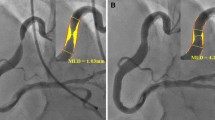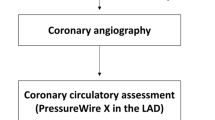Abstract
Background
Current diagnostic criteria for coronary spasm are based on patient’s symptoms, ECG shifts and epicardial vasoconstriction during acetylcholine (ACh) spasm testing.
Aims
To assess the feasibility and diagnostic value of coronary blood flow (CBF) and resistance (CR) assessment as objective parameters during ACh testing.
Methods
Eighty-nine patients who underwent intracoronary reactivity testing including ACh testing with synchronous Doppler wire-based measurements of CBF and CR were included. Coronary microvascular and epicardial spasm, respectively, were diagnosed based on COVADIS criteria.
Results
Patients were 63 ± 13 years old, predominantly female (69%) and had preserved LV ejection fraction (64 ± 8%). Overall, assessment of CBF and CR during ACh testing revealed a decrease in CBF of 0.62 (0.17–1.53)-fold and an increase of CR of 1.45 [0.67–4.02]-fold in spasm patients compared to 2.08 (1.73–4.76) for CBF and 0.45 (0.44–0.63) for CR in patients without coronary spasm (both p < 0.01). Receiver operating characteristic revealed a high diagnostic ability of CBF and CR (AUC 0.86, p < 0.001, respectively) in identifying patients with coronary spasm. However, in 21% of patients with epicardial spasm and 42% of patients with microvascular spasm a paradoxical response was observed.
Conclusions
This study demonstrates feasibility and potential diagnostic value of intracoronary physiology assessments during ACh testing. We observed opposite responses of CBF and CR to ACh in patients with positive vs. negative spasm test. While a decrease in CBF and an increase in CR during ACh seem pathognomonic for spasm, some patients with coronary spasm demonstrate paradoxical ACh response demanding further scientific investigations.
Graphical abstract





Similar content being viewed by others
Abbreviations
- ACh:
-
Acetylcholine
- ANOCA:
-
Angina and non-obstructive coronary arteries
- APV:
-
Average peak flow velocity
- CAD:
-
Coronary artery disease
- CBF:
-
Coronary blood flow
- COVADIS:
-
Coronary vasomotor disorders international study group
- CR:
-
Coronary resistance
- TIMI:
-
Thrombolysis in myocardial infarction
References
Suda A, Takahashi J, Hao K et al (2019) Coronary functional abnormalities in patients with angina and nonobstructive coronary artery disease. J Am Coll Cardiol 74(19):2350–2360
Konst RE, Damman P, Pellegrini D et al (2021) Vasomotor dysfunction in patients with angina and nonobstructive coronary artery disease is dominated by vasospasm. Int J Cardiol 333:14–20
Ford TJ, Yii E, Sidik N et al (2019) Ischemia and no obstructive coronary artery disease: prevalence and correlates of coronary vasomotion disorders. Circ Cardiovasc Interv 12(12):e008126
Ong P, Camici PG, Beltrame JF et al (2018) International standardization of diagnostic criteria for microvascular angina. Int J Cardiol 250:16–20
MacAlpin RN, Weidner WA, Kattus AA Jr et al (1966) Electrocardiographic changes during selective coronary cineangiography. Circulation 34(4):627–637
Takahashi J, Suda A, Yasuda S et al (2021) Measurement of myocardial lactate production for diagnosis of coronary microvascular spasm. J Vis Exp. https://doi.org/10.3791/62558
Sun H, Fukumoto Y, Ito A et al (2005) Coronary microvascular dysfunction in patients with microvascular angina: analysis by TIMI frame count. J Cardiovasc Pharmacol 46(5):622–626
Chugh SK, Koppel J, Scott M et al (2004) Coronary flow velocity reserve does not correlate with TIMI frame count in patients undergoing non-emergency percutaneous coronary intervention. J Am Coll Cardiol 44(4):778–782
Guenther F, Seitz A, Pereyra VM et al (2020) Does coronary microvascular spasm exist? Objective evidence from intracoronary doppler flow measurements during acetylcholine testing. Cardiovasc Innov Appl 4(3):205–209
Seitz A, Beck S, Pereyra VM et al (2021) Testing acetylcholine followed by adenosine for invasive diagnosis of coronary vasomotor disorders. J Vis Exp. https://doi.org/10.3791/62134
Beltrame JF, Crea F, Kaski JC et al (2017) International standardization of diagnostic criteria for vasospastic angina. Eur Heart J 38(33):2565–2568
Ong P, Camici PG, Beltrame JF et al (2017) International standardization of diagnostic criteria for microvascular angina. Int J Cardiol 250:16–20
Doucette JW, Corl PD, Payne HM et al (1992) Validation of a Doppler guide wire for intravascular measurement of coronary artery flow velocity. Circulation 85(5):1899–1911
Meuwissen M, Chamuleau SA, Siebes M et al (2001) Role of variability in microvascular resistance on fractional flow reserve and coronary blood flow velocity reserve in intermediate coronary lesions. Circulation 103(2):184–187
Langenberg CJ, Pietersen HG, Geskes G et al (2003) Coronary sinus catheter placement: assessment of placement criteria and cardiac complications. Chest 124(4):1259–1265
Gallinoro E, Paolisso P, Bermpeis K et al (2022) When “Slow Flow” Is Not “Low Flow.” JACC Cardiovasc Interv 15:e119–e121
Ohba K, Sugiyama S, Sumida H et al (2012) Microvascular coronary artery spasm presents distinctive clinical features with endothelial dysfunction as nonobstructive coronary artery disease. J Am Heart Assoc 1(5):e002485
Mohri M, Koyanagi M, Egashira K et al (1998) Angina pectoris caused by coronary microvascular spasm. Lancet 351(9110):1165–1169
Feenstra RGT, Seitz A, Boerhout CKM et al (2022) Principles and pitfalls in coronary vasomotor function testing. EuroIntervention 17(15):1271–1280
Funding
This work was supported by the Robert-Bosch-Foundation, Stuttgart, Germany, and the Berthold-Leibinger-Foundation, Ditzingen, Germany.
Author information
Authors and Affiliations
Corresponding author
Ethics declarations
Conflict of interest
The authors declare that they have no conflicts of interest.
Rights and permissions
Springer Nature or its licensor (e.g. a society or other partner) holds exclusive rights to this article under a publishing agreement with the author(s) or other rightsholder(s); author self-archiving of the accepted manuscript version of this article is solely governed by the terms of such publishing agreement and applicable law.
About this article
Cite this article
Seitz, A., Martínez Pereyra, V., Froebel, S. et al. Characterization and implications of intracoronary hemodynamic assessment during coronary spasm provocation testing. Clin Res Cardiol 112, 1312–1321 (2023). https://doi.org/10.1007/s00392-023-02224-1
Received:
Accepted:
Published:
Issue Date:
DOI: https://doi.org/10.1007/s00392-023-02224-1




